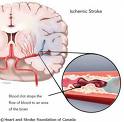Diagnosis of Stroke

Diagnosis
Stroke is diagnosed through several techniques: a neurological examination, CT scans (most often without contrast enhancements) or MRI scans, Doppler ultrasound, and arteriography. The diagnosis of stroke itself is clinical, with assistance from the imaging techniques. Imaging techniques also assist in determining the subtypes and cause of stroke. There is yet no commonly used blood test for the stroke diagnosis itself, though blood tests may be of help in finding out the likely cause of stroke.
How is a stroke diagnosed?
A stroke is a medical emergency. Anyone suspected of having a stroke should be taken to a medical facility immediately for evaluation and treatment. Initially, the doctor takes a medical history from the patient if he/she is alert or others familiar with the patient if they are available, and performs a physical examination. If a person has been seeing a particular doctor, it would be ideal for that doctor to participate in the assessment. Previous knowledge of the patient can improve the accuracy of the evaluation.
A neurologist, a doctor specializing in disorders of the nervous system and diseases of the brain, will often assist in the diagnosis and management of stroke patients.
Just because a person has slurred speech or weakness on one side of the body does not necessarily signal the occurrence of a stroke. There are many other possibilities that can be responsible for these symptoms. Other conditions that can mimic a stroke include:
• brain tumors,
• a brain abscess (a collection of pus in the brain caused by bacteria or a fungus),
• migraine headache,
• bleeding in the brain either spontaneously or from trauma,
• meningitis or encephalitis,
• an overdose of certain medications, or
• an imbalance of sodium, calcium, or glucose in the body can also cause changes in the nervous system that can mimic a stroke.
In the acute stroke evaluation, many things will occur at the same time. As the physician is taking the history and performing the physical examination, nursing staff will begin monitoring the patient's vital signs, getting blood tests, and performing an electrocardiogram (EKG or ECG).
Part of the physical examination that is becoming standardized is the use of a stroke scale. The American Heart Association has published a guide to the examination of the nervous system to help care providers determine the severity of a stroke and whether aggressive intervention may be warranted.
There is a narrow time frame to intervene in an acute stroke with medications to reverse the loss of blood supply to part of the brain (please see TPA below). The patient needs to be appropriately evaluated and stabilized before any clot-busting drugs can be potentially utilized.